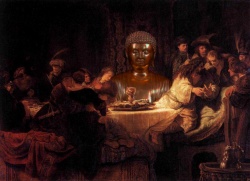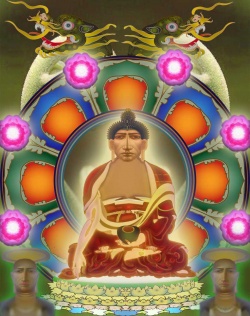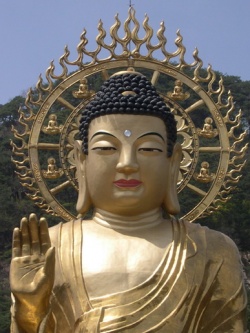Introduction to the Three Signs
Heedfulness is the path to the deathless, carelessness is the path to death.
The heedful do not die; the careless are as if already dead.
Introduction
The primary Buddhist tenet that all things can be separated into component parts is not intended to suggest a static world of composite objects. Rather, all things are seen to exist in the form of a stream. Each constituent element of that stream comes into being in dependence on other elements in an unbroken flow of appearance and decline. No single element has an independent fixed identity; they are all impermanent and unstable. Indeed, the fluid nature of phenomena is possible owing to the interdependence and insubstantiality of their components.
This stream of conditioned phenomena is constant (dhamma-dhātu) and certain (dhammaṭṭhiti), and it is a part of a natural order (dhamma-niyāma).1 It does not rely for its existence on a god, religion or prophet. In Buddha-Dhamma the role of a Teacher is that of discovering and explaining this truth to others.
The Buddha presented the teaching of the Three Characteristics (tilakkhaṇa) to describe this natural law of flux.2 The teaching is outlined in this way:
Whether Buddhas appear or not, this truth (dhātu) is constant and stable … that is:
All conditioned phenomena (saṅkhāra) are impermanent….
All conditioned phenomena are dukkha….3
All things (dhamma) are nonself….
Having fully awakened to and penetrated to this truth, a Tathāgata announces it, teaches it, clarifies it, formulates it, reveals it, and analyzes it: that all conditioned phenomena are impermanent, all conditioned phenomena are dukkha, and all things are nonself. 4
Definitions of the three characteristics are as follows:
Aniccatā: impermanence, instability, and inconstancy; the condition of arising, deteriorating, and disintegrating.
Dukkhatā: state of dukkha; the condition of oppression by birth and decay; the inherent stress, resistance and conflict within an object due to alteration of its determinant factors, preventing it from remaining as it is; the internal imperfection of things, which prevents true satisfaction for someone whose desires are influenced by craving (taṇhā), and causes suffering for a person who clings (upādāna).
Anattatā: the condition of anattā—nonself; the condition of things being void of a real abiding self that owns or controls phenomena.5
The Pali adjectival terms for these characteristics are anicca, dukkha, and anattā, respectively. The abstract noun forms are aniccatā, dukkhatā, and anattatā. As characteristics they are known as anicca-lakkhaṇa, dukkha-lakkhaṇa, and anatta-lakkhaṇa. The commentaries occasionally refer to the three characteristics as ‘universal characteristics’ (sāmañña-lakkhaṇa).
All conditioned things exist in a state of flux, made up of interdependent conditioning factors, which arise and pass away in unbroken succession: things are impermanent. Because of their instability and causal dependence, conditioned things are subject to stress and friction, revealing an inherent imperfection. And all things, both conditioned things and the Unconditioned, exist according to their nature; they possess no self that acts as owner or governor of phenomena.
Human beings too are comprised of constituent elements. The ‘building-blocks’ for human beings are the five aggregates (khandha); nothing else exists besides the five aggregates. When we examine the five aggregates in turn, we see that each one is impermanent. Being impermanent, they are dukkha; they are distressing for one who grasps them. Being dukkha, they are selfless. They are selfless because each aggregate arises from causes; they are not independent entities. Furthermore, they are not truly subject to a person’s control or ownership. If one were to truly own the five aggregates, one would be able to control them according to one’s will and prohibit them from change, for example from debility or disease.
Many scholars have tried to prove that the Buddha acknowledged a self existing apart from the five aggregates. They claim that he only repudiated a self within conditioned phenomena and that he affirmed an ultimate self. Moreover, they explain that Nibbāna is the same as ātman/attā: Nibbāna is the Self. I will elaborate on this matter in Part IV of Buddhadhamma, on Nibbāna.
Most people, especially those who have grown up in a culture espousing a soul, tend to seek out and seize some concept of a fixed identity. Acting in this way satisfies a hidden, unconscious need. When their self-identification as one or more of the five aggregates becomes untenable, they create a new concept of self in which to believe. But the aim of Buddha-Dhamma is not to release one thing so as to grasp another, or to be freed from one thing only to then be enslaved by something else. As mentioned earlier, things exist according to their own nature. Their nature of existence is determined by selflessness; if things were to possess a self then by definition they could not exist as they do.
Endnotes:
1 The Abhidhamma commentaries divide niyāma, natural laws, into five kinds:
Utu-niyāma (physical laws): laws concerning human beings’ external environment, e.g., laws governing temperature, weather and seasons.
Bīja-niyāma (genetic laws): laws concerning reproduction, including heredity.
Citta-niyāma (psychic laws): laws concerning mental activities.
Kamma-niyāma (karmic laws): laws concerning intention and human behaviour, i.e., the law of actions (kamma) and their results.
Dhamma-niyāma: general laws of nature, especially those of cause and effect; laws concerning the interrelationship of all things.
(DA. II. 432; DhsA. 272)
2 Another key teaching by the Buddha is on Dependent Origination (paṭiccasamuppāda). This teaching describes the law of flux from a different angle and illustrates the same truth. The Three Characteristics shows the properties of all things, properties that comply with the relationship outlined in Dependent Origination. Dependent Origination describes the conditioned flow of phenomena, revealing the three characteristics.
3 [The word dukkha is notoriously difficult to translate. The most common translations include: Suffering, unsatisfactoriness, stress, pain and misery. Many misunderstandings have arisen by translating the second characteristic as: ‘Everything is suffering’ or ‘Life is suffering.’ For the different contexts in which the term dukkha is used see below. Please note that when I use the terms ‘stressful’ and ‘under stress’ I am referring to the pressure and tension inherent in all things.]
4 A. I. 286.
5 [Note that I have translated anattā as ‘nonself,’ ‘not-self,’ or ‘selfless,’ according to the context. The Pali attā (Sanskrit ātman) is most often translated as ‘self’ or ‘soul’; I have used both, again according to the context. The words ‘selfless’ and ‘selflessness’ here should not be confused with the standard definition of being altruistic.]




